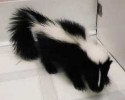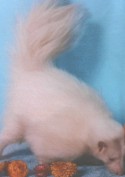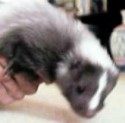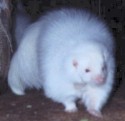|
Skunk Color Variations and Markings ...
Many different colors can exist in skunk pelts. Ranging from
very dark to very light each skunk will generally fall into one
of these main categories. The most confusing thing about
discussing skunk coloring is vocabulary. Everyone seems
to have a different name for virtually the same color.
We will list some of the more common names below.
The different fur markings on skunks are pretty easy to understand.
There are only five classifications and they are pretty clear cut.
Below you will find an explanation and example of each one.

Black
This is the classic skunk color. Black fur covers the skunks
body and will always have white mixed in.
Top » 

Brown
Any shade of brown fur is the determining factor in this color
category. Browns can range from very light tan to very dark
brown, appearing almost black. White appears on all brown coats.
A common name for brown is chocolate. The name red or cinnamon
relates to skunks with brown coats possessing a reddish highlight.
Mahogonany is a case where dark brown fur contains both red and
black highlights together.
Top » 

Cream
This color comprises any shade of beige fur. Ranging from a
very light tan to an off-white fur these skunks often sport
a white stripe too. Commonly called apricot, beige, champagne,
or blonde; this category is becoming increasingly popular.
Skunks in this category sport dark brown or black eyes.
Top » 

Gray
A gray coloring is fairly rare and is determined by gray
and white fur. This category is sometimes called smoke.
A very special and rare case of gray fur is Lavendar.
Lavendar skunks can be gray or black and white speckled
where the coat appears to take on a purplish hue.
Top » 

White
Albinos are determined by all white fur and the presence
of pink eyes. If your skunk has all white fur, but has
dark brown or black eyes it is called a "white with dark
eyes". Some white skunks even have a white stripe on
off-white fur; this is called a white on white.
Top » 

Star

|
This marking is determined by the absence of a white striping
pattern. A white patch or "star" dons the top of the head and
is sometimes accompanied by a white blaze on the front of
the face. This marking is fairly rare and is observed mostly
on black skunks. A variation on this marking where the white
patch on the skunk's head tapers down into a partial stripe
on the skunk's back is called a "falling star".
|

|
Top » 

Classic Stripe

|
A prominently defined double white stripe that extends down
the skunk's back usually joining together at the head and/or
tail defines this marking. In addition, the front legs,
back legs, and hind quarters are absent of white spots.
This marking is the most common and is seen on all
colors, sometimes even off-white.
|

|
Top » 

Silverback

|
This fur marking is a special case of the Classic Stripe. One
wide white stripe runs down the skunk's back usually from the
head to the tail. Quite often you will see accompanying white
spots elsewhere on the skunk as well. This pattern is fairly
common and appears mainly on black and brown skunks.
|
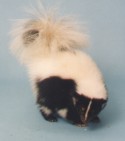
|
Top » 

Chip
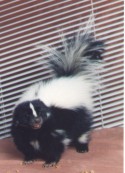
|
The presence of white "chip(s)" or spot(s) on one or all
four legs or hind quarters is the main determining factor
with this marking. Almost always the white "chips" appear
along with a white striping pattern running down the back
as well. This marking is fairly common and is found on
black and brown skunks. A commonly used name associated
with brown skunks having "chips" is "Chocolate Chip".
|

|
Top » 

Other Markings

|
Any skunk that misses falling into one of the above
categories would be placed here. Skunks where the
white and color appear to blend together and no real
striping pattern is observed belong to this marking
category. These markings are pretty rare since most skunks
fall into one of the categories mentioned above.
|

|
Webmaster:
Tacy A. Kessler. Copyright © 2001
OOPS,
all rights reserved.
Images, artwork, and verbiage are the
sole property of the designer and
may not be used in any form
without express written permission.
|
![]()


